Lockheed Martin/Boeing F-22 Raptor Videos
|
Loading...
|
|
|
Loading...
|
|
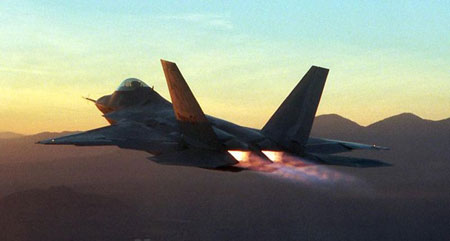 |
Maximum speed: At altitude: Mach 2.25 (1,500 mph, 2,410 km/h) Supercruise: Mach 1.82 (1,220 mph, 1,963 km/h) Range: 1,600 nmi (1,840 mi, 2,960 km) Combat radius: 410 nmi (471 mi, 759 km) |
F-22 Raptor Video - Lockheed Martin Production
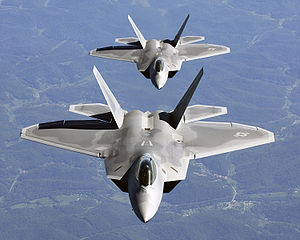
(Image: Two F-22 Raptors in close trail formation)
The Lockheed Martin/Boeing F-22 Raptor is a fighter aircraft that uses stealth technology. It is primarily an air superiority fighter, but has multiple capabilities that include ground attack, electronic warfare, and signals intelligence roles.
The United States Air Force considers the F-22 a critical component of the U.S. strike force. The USAF states that the F-22 cannot be matched by any known or projected fighter aircraft. Air Chief Marshal Angus Houston, Chief of the Australian Defence Force, said in 2004 that the "F-22 will be the most outstanding fighter plane ever built."
Faced with a protracted and costly development period, the aircraft was variously designated F-22 and F/A-22 during the three years before formally entering US Air Force service in December 2005, as the F-22A. Lockheed Martin Aeronautics is the prime contractor and is responsible for the majority of the airframe, weapon systems and final assembly of the F-22. Program partner Boeing Integrated Defense Systems provides the wings, aft fuselage, avionics integration, and all of the pilot and maintenance training systems.
Development
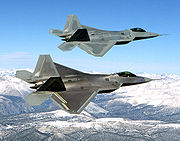
(Image: Two F-22s during flight testing, the upper one being the first EMD F-22, "Raptor 01")
In 1981 the United States Air Force (USAF) developed a requirement for a new air superiority fighter, the Advanced Tactical Fighter (ATF), to replace the capability of the F-15 Eagle, primarily the F-15A, B, C and D variants. ATF was a demonstration and validation program undertaken by the USAF to develop a next-generation air superiority fighter to counter emerging worldwide threats, including development and proliferation of Soviet-era Su-27 "Flanker"-class fighter aircraft. It was envisaged that the ATF would incorporate emerging technologies including advanced alloys and composite materials, advanced fly-by-wire flight control systems, higher power propulsion systems, and low-observable/stealth technology.
A request for proposal (RFP) was issued in July 1986, and two contractor teams, Lockheed/Boeing/General Dynamics and Northrop/McDonnell Douglas were selected in October 1986 to undertake a 50-month demonstration/validation phase, culminating in the flight test of two prototypes, the YF-22 and the YF-23.
On 23 April 1991 the USAF ended the design and test flight competition by announcing Lockheed's YF-22 as the winner. It was anticipated at the time that 650 aircraft would be ordered.
Into production
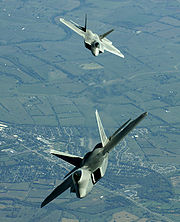
(Image: F-22 Raptors over Utah in their first official deployment, October 2005)
The first production F-22 was delivered to Nellis Air Force Base, Nevada, on 14 January 2003 and "Dedicated Initial Operational Test and Evaluation" commenced on 27 October 2003. By 2004, 51 Raptors were in service.
The first crash of a production F-22 occurred during takeoff at Nellis Air Force Base on 20 December 2004, in which the pilot ejected safely prior to impact. The crash investigation revealed that a brief interruption in power during an engine shutdown prior to flight caused a malfunction in the flight-control system; consequently, the aircraft design was corrected to avoid the problem.
In August 2007, the United States Air Force signed a $5 billion, multi-year contract with Lockheed Martin that will extend production to 2011, and as of 2008, F-22 Raptors are being procured at the rate of 20 per year.
In a ceremony on 29 August 2007, Lockheed Martin reached its "100th F-22 Raptor" milestone, delivering AF Serial No. 05-4100.
Procurement
The United States Air Force originally planned to order 750 ATFs, with production beginning in 1994; however, the 1990 Major Aircraft Review altered the plan to 648 aircraft beginning in 1996. The goal changed again in 1994, when it became 442 aircraft entering service in 2003 or 2004, but a 1997 Department of Defense report put the purchase at 339. In 2003, the Air Force said that the existing congressional cost cap limited the purchase to 277. By 2006, the Pentagon said it will buy 183 aircraft, which would save $15 billion but raise the cost of each aircraft, and this plan has been de facto approved by Congress in the form of a multi-year procurement plan, which still holds open the possibility for new orders past that point. The total cost of the program by 2006 was $62 billion.
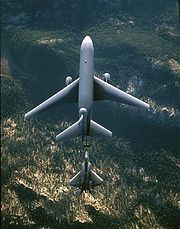
(Image: A KC-10 Extender (top) refuels an F-22 Raptor)
In April 2006, the cost of the F-22 was assessed by the Government Accountability Office to be $361 million per aircraft. This cost reflects the F-22 total program cost, divided by the number of fighters the Air Force is programmed to buy; and which has so far invested $28 billion in the Raptor's research, development and testing. That money, referred to as a "sunk cost", is already spent and is separate from money used for future decision-making, including procuring a copy of the jet. The Unit Procurement Cost was estimated at $177.6 million in 2006 based on a production run of 181 airframes. This unit cost will decrease if total production is higher. This cost includes $3.233 billion already spent on research and development by 2006.
By the time all 183 fighters have been purchased, $34 billion will have been spent on actual procurement, resulting in a total program cost of $62 billion or about $339 million per aircraft. The incremental cost for one additional F-22 is around $138 million; decreasing with larger volumes. If the Air Force were to buy 100 more F-22s today, the cost of each one would be less and would continue to drop with additional aircraft purchases.
The F-22 is not the most expensive aircraft aloft. That distinction likely belongs to the roughly $2.2 billion-per-unit B-2 Spirit, whose orders went from hundreds to a few dozen when the Cold War ended thus making the unit cost skyrocket, though the incremental cost was under US$1 billion. The F-22 uses fewer radar absorbent materials than the B-2 or F-117 Nighthawk, which is expected to translate into lower maintenance costs.
On 31 July 2007, Lockheed Martin received a multiyear contract for 60 F-22s worth a total of US$7.3 billion. The contract brings the number of F-22s on order to 183 and extends production through 2011.
During the two-month grounding of nearly 700 older F-15s in November and December 2007, some US Senators demanded that Deputy Secretary of Defense Gordon England release three government reports that support additional F-22 Raptors beyond the planned 183 jets. The USAF has requested that the F-22 remain in production after the 183 planned fighters. This is believed to be a response to the recent grounding of F-15A-D fighters.
In January 2008, the Pentagon announced that it would ask Congress for funds to buy additional F-22s to replace other aircraft lost in combat, and proposed that $497 million that would have been used to shut down the F-22 line instead be used to buy four more F-22s, keeping open the production line beyond 2011 and providing the next Presidential administration the option to buy even more F-22s. The funds earmarked for the line shutdown, however, were directed by Pentagon Comptroller Tina W. Jonas on 17 December 2007, to be used to fund repairs to the F-15 fleet caused by the worldwide grounding of that aircraft in November 2007. This diversion had the same effect of postponing the decision to shut down the F-22 production line until at least 2009. On September 24, 2008, US Congress passed a defense spending bill with funding for F-22 long lead items for future production. On November 12, 2008, the Pentagon released $50 million of the $140 million approved by Congress to buy parts for an additional four planes, thus leaving the Raptor program in the hands of the incoming Obama Administration. Additional funds to complete the four planes will be provided in a future war supplemental bill, which would bring the total planes procured to 187.
Ban on exports
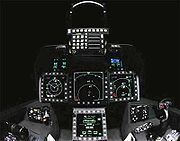
(Image: Cockpit of the F-22, showing instruments and heads up display)
The opportunity for export is currently non-existent because the export sale of the F-22 is barred by American federal law. Most current customers for U.S. fighters are either acquiring earlier designs like the F-15 or F-16, or else are waiting to acquire the F-35, which contains much of the F-22's technology but is designed to be cheaper and more flexible. Independent writers have suggested that F-22 may not be offered for export in order not to damage the lucrative F-35 export program.
The Japanese government reportedly showed some interest in buying F-22s in its Replacement-Fighter program for the Japan Air Self-Defense Force (JASDF). In such an event, it would most likely involve a "watered-down" export variant while still retaining most of its advanced avionics and stealth characteristics. However, such a proposal would still need approval from the Pentagon, State Department and Congress.
Israeli Air Force (IAF) chief procurement officer Brigadier-General Ze'ev Snir said that, "The IAF would be happy to equip itself with 24 F-22s, but the problem at this time is the US refusal to sell the aircraft, and its $200 million price tag."
Some Australian politicians and defense commentators have proposed that Australia purchase F-22s instead of the F-35. In 2006, the Australian Labor Party supported this proposal on the grounds that the F-22 is a proven, highly capable aircraft, while the F-35 is still under development. However, the Howard government ruled out purchase of the F-22, on the grounds that it is unlikely to be released for export, and does not have sufficient ground/maritime strike capacity. This assessment was supported by the Australian Strategic Policy Institute, which claimed that the F-22 "has insufficient multi-role capability at too high a price." The ASPI analysis was, however, criticized by Air Power Australia.
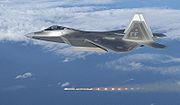
(Image: An F-22 fires an AIM-120 AMRAAM)
The US Congress upheld the ban on F-22 Raptor foreign sales during a joint conference on 27 September 2006. After talks in Washington in December 2006, the US DoD reported the F-22 would not be available for foreign sale.
In 2007, the Australian government ordered a review of plans to procure the F-35 and F/A-18E/F Super Hornet. This review will include an evaluation of the F-22's suitability for Australia; moreover, Defence Minister Joel Fitzgibbon has stated: "I intend to pursue American politicians for access to the Raptor". In February 2008, U.S. Defense Secretary Robert Gates said he had no objection to sale of the Raptor to Australia, but Congress would have to change the law.
Design
Characteristics
The F-22 is a fifth generation fighter that is considered a fourth-generation stealth aircraft by the USAF. Its dual afterburning Pratt & Whitney F119-PW-100 turbofans incorporate pitch axis thrust vectoring, with a range of ±20 degrees. The maximum thrust is classified, though most sources place it at about 35,000 lbf (156 kN) per engine. Maximum speed, without external weapons, is estimated to be Mach 1.82 in supercruise mode; as demonstrated by General John P. Jumper, former US Air Force Chief of Staff, when his Raptor exceeded Mach 1.7 without afterburners on 13 January 2005. With afterburners, it is "greater than Mach 2.0" (1,317 mph, 2,120 km/h), according to Lockheed Martin; however, the Raptor can easily exceed its design speed limits, particularly at low altitudes, with max-speed alerts to help prevent the pilot from exceeding them. Former Lockheed Raptor chief test pilot Paul Metz stated that the Raptor has a fixed inlet; but while the absence of variable intake ramps may theoretically make speeds greater than Mach 2.0 unreachable, there is no evidence to prove this. Such ramps would be used to prevent engine surge resulting in a compressor stall, but the intake itself may be designed to prevent this. Metz has also stated that the F-22 has a top speed greater than 1,600 mph (Mach 2.42) and its climb rate is faster than the F-15 Eagle due to advances in engine technology, despite the F-15's thrust-to-weight ratio of about 1.2:1, with the F-22 having a ratio closer to 1:1. The US Air Force claims that the F-22A cannot be matched by any known or projected fighter.
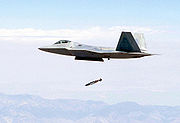
(Image: An F-22 releases a JDAM from its center internal bay while flying at supersonic speed)
The true top-speed of the F-22 is unknown to the general public. The ability of the airframe to withstand the stress and heat from friction is a further, key factor, especially in an aircraft using as many polymers as the F-22. However, while some aircraft are faster on paper, the internal carriage of its standard combat load allows the aircraft to reach comparatively higher performance with a heavy load over other modern aircraft due to its lack of drag from external stores. It is one of only a handful of aircraft that can sustain supersonic flight without the use of afterburner augmented thrust (and its associated high fuel usage). This ability is called supercruise.
The F-22 is highly maneuverable, at both supersonic and subsonic speeds. It is extremely departure-resistant, enabling it to remain controllable at extreme pilot inputs. The F-22's thrust vectoring nozzles allow the aircraft to turn tightly, and perform extremely high alpha (angle of attack) maneuvers such as the Herbst maneuver (or J-turn), Pugachev's Cobra, and the Kulbit, though the J-Turn is more useful in combat. The F-22 is also capable of maintaining a constant angle of attack of over 60°, yet still having some control of roll. During June 2006 exercises in Alaska, F-22 pilots demonstrated that cruise altitude has a significant effect on combat performance, and routinely attributed their altitude advantage as a major factor in achieving an unblemished kill ratio against other US fighters and 4th/4.5th generation fighters.
Avionics
The F-22's avionics include BAE Systems E&IS radar warning receiver (RWR) AN/ALR-94, AN/AAR 56 Infra-Red and Ultra-Violet MAWS (Missile Approach Warning System) and the Northrop Grumman AN/APG-77 Active Electronically Scanned Array (AESA) radar. The AN/APG-77 has both long-range target acquisition and low probability of interception of its own signals by enemy aircraft.
The AN/ALR-94 is a passive receiver system capable of detecting the radar signals in the environment. Composed of more than 30 antennas smoothly blended into the wings and fuselage, it is described by the former head of the F-22 program at Lockheed Martin Tom Burbage as "the most technically complex piece of equipment on the aircraft." With greater range (250+ nmi) than the radar, it enables the F-22 to limit its own radar emission which might otherwise compromise its stealth. As the target approaches, AN/ALR-94 can cue the AN/APG-77 radar to keep track of its motion with a narrow beam, which can be as focused as 2° by 2° in azimuth and elevation.
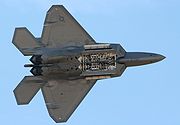
(Image: To maintain stealth, the F-22 carries its weapons in internal bays, here shown open)
The AN/APG-77 AESA radar, designed for air-superiority and strike operations, features a low-observable, active-aperture, electronically-scanned array that can track multiple targets in all kinds of weather. The AN/APG-77 changes frequencies more than 1,000 times per second to reduce the chance of being intercepted. The radar can also focus its emissions to overload enemy sensors, giving the aircraft an electronic-attack capability.
The radar’s information is processed by two Raytheon Common Integrated Processor (CIP)s. Each CIP operates at 10.5 billion instructions per second and has 300 megabytes of memory. Information can be gathered from the radar and other onboard and offboard systems, filtered by the CIP, and offered in easy-to-digest ways on several cockpit displays, enabling the pilot to remain on top of complicated situations. The Raptor’s software is composed of over 1.7 million lines of code, most of which concerns processing data from the radar. The radar has an estimated range of 125-150 miles, though planned upgrades will allow a range of 250 miles (400 km) or more in narrow beams.
The F-22 has several unique functions for an aircraft of its size and role. For instance, it has threat detection and identification capability along the lines of that available on the RC-135 Rivet Joint. While the F-22's equipment isn't as powerful or sophisticated, because of its stealth, it can be typically hundreds of miles closer to the battlefield, which often compensates for the reduced capability.
The F-22 is capable of functioning as a "mini-AWACS." Though reduced in capability compared to dedicated airframes such as the E-3 Sentry, as with its threat identification capability, the F-22's forward presence is often of benefit. The system allows the F-22 to designate targets for cooperating F-15s and F-16s, and even determine if two friendly aircraft are targeting the same enemy aircraft, thus enabling one of them to choose a different target. It is often able to identify targets "sometimes many times quicker than the AWACS," than accompanying dedicated AWACS.
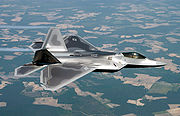
(Image: The 27th Fighter Squadron at Langley Air Force Base was the first squadron to receive the F-22)
The F-22's low probability of intercept radar is being given a high-bandwidth data transmission capability, to allow it to be used in a "broadband" role to permit high-speed relaying of data between friendly transmitters and receivers in the area. The F-22 can already pass data to other F-22s, resulting in considerably reduced radio "chatter."
The IEEE-1394B data bus, developed for the F-22, was derived from the commercial IEEE-1394 "FireWire" bus system, often used on personal computers. The same data bus is employed by the subsequent F-35 Lightning II fighter.
Cockpit
The F-22 cockpit is a glass cockpit design without any traditional analog flight instruments and represents a marked improvement on the cockpit design of previous advanced aircraft. The leading features of the F-22 cockpit include simple and rapid start-up, highly developed HMI, light helmet, large anthropometric accommodation and highly integrated warning system. Other main features include the large single-piece canopy and improved life support systems.
Airframe
Several small design changes were made from the YF-22A prototype to the production F-22A. The swept-back angle on the wing's leading edge was decreased from 48 degrees to 42 degrees, while the vertical stabilizer area was decreased 20%. To improve pilot visibility, the canopy was moved forward 7 inches (178 mm) and the engine intakes were moved rearward 14 inches (356 mm). The shape of the wing and stabilator trailing edges was refined to improve aerodynamics, strength, and stealth characteristics. The Airframe also features an internal missile bay, streamlining the aircraft.
Armament
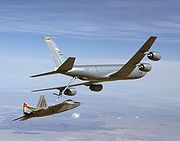
(Image: An F-22 refuels from a KC-135 during testing; the attachment on the back top is for a spin recovery chute)
The Raptor is designed to carry air-to-air missiles in internal bays, both to avoid disrupting its stealth capability and to reduce drag resulting in higher top speeds and longer combat ranges. Launching missiles requires opening the weapons bay doors for less than a second, while the missiles are pushed clear of the airframe by hydraulic arms. The aircraft can also carry bombs compatible with the Joint Direct Attack Munition (JDAM) guidance system, and the new Small-Diameter Bomb (SDB). The Raptor carries an M61A2 Vulcan 20 mm rotary cannon, also with a trap door, in the right wing root. The M61A2 is a last ditch weapon, and carries only 480 rounds; enough ammunition for approximately five seconds of sustained fire. Despite this, the F-22 has been able to use its gun in dogfighting without being detected, which can be necessary when missiles are depleted.
The Raptor's very high sustained cruise speed and operational altitude add significantly to the effective range of both air-to-air and air-to-ground munitions. These factors may be the rationale behind the USAF's decision not to pursue long-range, high-energy air-to-air missiles such as the MBDA Meteor. However, the USAF plans to procure the AIM-120D AMRAAM, which will have a significant increase in range compared to the AIM-120C. The Raptor launch platform provides additional energy to the missile which helps improve the range of air-to-ground ordnance. While specific figures remain classified, it is expected that JDAMs employed by F-22s will have twice or more the effective range of munitions dropped by legacy platforms. In testing, a Raptor dropped a 1,000 lb (450 kg) JDAM from 50,000 feet (15,000 m), while cruising at Mach 1.5, striking a moving target 24 miles (39 km) away. The SDB, as employed from the F-22, should see even greater increases in effective range, due to the improved lift to drag ratio of these weapons.
While in its air-superiority configuration, the F-22 carries its weapons internally, though it is not limited to this option. The wings are capable of supporting four detachable hardpoints. Each hardpoint is theoretically capable of handling 5,000 lb (2,300 kg) of ordnance. However, use of external stores greatly compromises the F-22's stealth, and has a detrimental effect on maneuverability, speed, and range. As many as two of these hardpoints are "plumbed", allowing the usage of external fuel tanks. The hardpoints are detachable in flight allowing the fighter to regain its stealth once these external stores are exhausted. Currently, there is research being conducted to develop a stealth ordnance pod and hardpoints for it. Such a pod would comprise a stealth shape and carry its weapons internally, then would split open when launching a missile or dropping a bomb. Both the pod and hardpoints could be detached when no longer needed. This system would allow the F-22 to carry its maximum ordnance load while remaining stealthy, albeit at a loss of maneuverability.
Stealth
(Image: An F-22 observes as an F-15 Eagle banks left. The F-22 is slated to replace the F-15C/D)
Although several recent Western fighter aircraft are less detectable on radar than previous designs using techniques such as radar absorbent material-coated S-shaped intake ducts that shield the compressor fan from reflecting radar waves, the F-22 design placed a much higher degree of importance on low observance throughout the entire spectrum of sensors including radar signature, visual, infrared, acoustic, and radio frequency.
The stealth of the F-22 is due to a combination of factors, including the overall shape of the aircraft, the use of radar absorbent material (RAM), and attention to detail such as hinges and pilot helmets that could provide a radar return. However, reduced radar cross section is only one of five facets that designers addressed to create a stealth design in the F-22. The F-22 has also been designed to disguise its infrared emissions to make it harder to detect by infrared homing ("heat seeking") surface-to-air or air-to-air missiles. Designers also made the aircraft less visible to the naked eye, and controlled radio and noise emissions. The Raptor has an under bay carrier made for hiding heat from missile threats, like surface-to-air missiles.
The F-22 apparently relies less on maintenance-intensive radar absorbent material and coatings than previous stealth designs like the F-117. These materials caused deployment problems due to their susceptibility to adverse weather conditions. Unlike the B-2, which requires climate-controlled hangars, the F-22 can undergo repairs on the flight line or in a normal hangar. Furthermore, the F-22 has a warning system (called "Signature Assessment System" or "SAS") which presents warning indicators when routine wear-and-tear have degraded the aircraft's radar signature to the point of requiring more substantial repairs. The exact radar cross section of the F-22 remains classified.
External lighting
The aircraft has integral position and anti-collision lighting (including strobes) on the wings, compatible with stealth requirements, supplied by Goodrich Corporation. The low voltage electroluminescent formation lights are located on the aircraft at critical positions for night flight operations (on both sides of the forward fuselage under the chin, on the tip of the upper left and right wings, and on the outside of both vertical stabilizers). There are similar air refueling lights on the butterfly doors that cover the air refueling receptacle.
Operational history
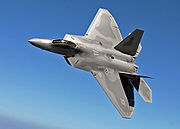
(Image: An F-22 of the 27th Fighter Squadron)
Intended to be the leading American advanced tactical fighter in the early part of the 21st century, the Raptor is an expensive fighter with an incremental cost of about US$138 million per unit. The number of aircraft to be built has dropped to 183, down from the initial requirement of 750. Part of the reason for the decrease in the requirement is that the F-35 Lightning II uses much of the technology used on the F-22, but at a much more affordable price. To a large extent the cost of these technologies is lower for the F-35 only because they have already been developed for the F-22.
YF-22 "Lightning II"
The prototype YF-22 won a fly-off competition against the Northrop/McDonnell-Douglas YF-23 for the Advanced Tactical Fighter contract. In April 1992 during flight testing after contract award, test pilot Tom Morgenfeld escaped without injury when the first YF-22 prototype that he was flying crashed while landing at Edwards Air Force Base in California. The cause of the crash was found to be a flight control software error that failed to prevent a pilot-induced oscillation.
The YF-22 was a developmental aircraft that led to the F-22; however, there are significant differences between the YF-22 and the F-22. Relocation of cockpit, structural changes, and many other smaller changes exist between the two types. The two are sometimes confused in pictures, often at angles where it is difficult to see certain features. For example, there are some F-22 with pitot booms which some think are only found on the YF-22.
The YF-22 was originally given the unofficial name "Lightning II", after the World War II fighter P-38, by Lockheed, which persisted until the mid-1990s when the USAF officially named the aircraft "Raptor". For a short while, the aircraft was also dubbed "SuperStar" and "Rapier". The F-35 later received the Lightning II name on 7 July 2006.
F-22 Raptor to F/A-22 and back again
The production model was formally named F-22 "Raptor" when the first production-representative aircraft was unveiled on 9 April 1997 at Lockheed-Georgia Co., Marietta, Georgia. First flight occurred on 7 September 1997.
In September 2002, Air Force leaders changed the Raptor’s designation to F/A-22. The new designation, which mimicked that of the Navy’s F/A-18 Hornet, was intended to highlight plans to give the Raptor a ground-attack capability amid intense debate over the relevance of the expensive air-superiority jet. This was later changed back to simply F-22 on 12 December 2005. On 15 December 2005, the F-22A entered service.
Testing
Testing of the F-22 began in 1997 and has been curtailed to save program costs, but risks hiding flaws until a point at which fixing flaws becomes unaffordable. The U.S. General Accounting Office cautioned, "Moreover, engine and stealthiness problems already disclosed by the DoD, and the potential for avionics and software problems, underscore the need to demonstrate the weapon system’s performance through flight testing before significant commitments are made to production."
Raptor 4001 was retired and sent to Wright-Patterson AFB to be fired at for testing the fighter's survivability. Usable parts of 4001 would be used to make a new F-22. Another engineering and manufacturing development (EMD) F-22 was also retired and likely to be sent to be rebuilt. A testing aircraft was converted to a maintenance trainer at Tyndall AFB.
On 3 May 2006, a report was released detailing a problem with a forward titanium boom on the aircraft that was not properly heat treated. Officials are still investigating the problem which was caused by the boom portion not being subjected to high temperatures in the factory for long enough, causing the boom to be less ductile than specified and potentially shortening the lives of the first 80 or so F-22s. Work is underway to restore them to full life expectancy.
The F-22 fleet underwent modifications at Hill AFB, and at Edwards AFB near Palmdale, California.
Recent developments
In 2006, the Raptor's development team, composed of Lockheed Martin and over 1,000 other companies, plus the United States Air Force, won the Collier Trophy, American aviation's most prestigious award. The U.S. Air Force will acquire F-22s that are to be divided among seven active duty combat squadrons, and jointly flown and maintained by three integrated Air Force Reserve Command and Air National Guard fighter squadrons,
During Exercise Northern Edge in Alaska in June 2006, 12 F-22s of the 94th FS downed 108 adversaries with no losses in simulated combat exercises. In two weeks of exercises, the Raptor-led Blue Force amassed 241 kills against two losses in air-to-air combat, and neither Blue Force loss was an F-22.
This was followed with the Raptor's first participation in a Red Flag exercise. 14 F-22s of the 94th FS supported attacking Blue Force strike packages as well as engaging in close air support sorties themselves in Red Flag 07-1 between 3 February and 16 February 2007. Against designed superior numbers of Red Force Aggressor F-15s and F-16s, it established air dominance using eight aircraft during day missions and six at night, reportedly defeating the Aggressors quickly and efficiently, even though the exercise rules of engagement allowed for four to five Red Force regenerations of losses but none to Blue Force. Further, no sorties were missed because of maintenance or other failures, and only one Raptor was adjudged lost against the virtual annihilation of the defending force. When their ordnance was expended, the F-22s remained in the exercise area providing electronic surveillance to the Blue Forces.
While attempting its first overseas deployment to the Kadena Air Base in Okinawa, Japan, on 11 February 2007, a group of six Raptors flying from Hickam AFB, Hawaii experienced multiple computer crashes coincident with their crossing of the 180th meridian of longitude (the International Date Line). The computer failures included at least navigation (completely lost) and communication. The fighters were able to return to Hawaii by following their tankers in good weather. The error was fixed within 48 hours and the F-22s continued their journey to Kadena.
In 2007, tests carried out by Northrop Grumman, Lockheed Martin, and L-3 Communications enabled the AESA system of a Raptor to act like a WiFi access point, able to transmit data at 548 Megabit/sec and receive at Gigabit speed; far faster than the current Link 16 system used by US and allied aircraft, which transfers data at just over 1 Megabit/sec.
F-22A Raptors of the 90th Fighter Squadron performed their first intercept of two Russian Tu-95MS 'Bear-H' bombers in Alaska, on 22 November 2007. This was the first time that F-22s had been called to support a NORAD mission.
On 12 December 2007, General John D.W. Corley, USAF, Commander of Air Combat Command, officially declared the F-22s of the integrated active duty 1st Fighter Wing and Virginia Air National Guard 192d Fighter Wing fully operational, three years after the first Raptor arrived at Langley Air Force Base, Virginia. This was followed from 13 April to 19 April 2008 by an Operational Readiness Inspection (ORI) of the integrated wing in which it received an "excellent" rating in all categories while scoring a simulated kill-ratio of 221-0. The first pair of Raptors assigned to the 49th Fighter Wing became operational at Holloman Air Force Base, New Mexico, on 2 June.
In July 2008, F-22s were to be showcased in the 2008 Royal International Air Tattoo air show at RAF Fairford, but did not perform after the show was canceled due to bad weather. An F-22, however, performed on the first day of the Farnborough Airshow on 14 July 2008.
On 28 August, 2008, an F-22 from the 411th Flight Test Squadron performed in the first ever air-to-air refueling of an aircraft using synthetic jet fuel. The test was a part of the wider USAF effort to qualify all of its aircraft to use the fuel, a 50/50 mix of JP-8 and a Fischer-Tropsch process-produced, natural gas-based fuel. For the tests, no modifications were made to the F-22 nor the KC-135 Stratotanker which performed the refueling.
Variants
Under the Navalized Advanced Tactical Fighter (NATF) program, a carrier-borne variant of the F-22 with swing-wings was proposed for the U.S. Navy to replace the F-14 Tomcat, though the program was subsequently cancelled in 1993. A two-seat F-22B trainer variant was planned, but was cut in 1996 to save development costs.
Another more recent proposal is the FB-22, which would be used as a deep strike bomber for the USAF, but there has yet to be any word on whether the USAF plans further development of the program. Also, the X-44 MANTA, short for multi-axis, no-tail aircraft, was a planned experimental aircraft based on the F-22 with enhanced thrust vectoring controls and no aerodynamic backup (i.e. the aircraft is controlled solely by thrust vectoring, without rudders, ailerons, or elevators). Funding for the program was halted in 2000.
Specifications (F-22 Raptor)
General characteristics
Crew: 1
Length: 62 ft 1 in (18.90 m)
Wingspan: 44 ft 6 in (13.56 m)
Height: 16 ft 8 in (5.08 m)
Wing area: 840 ft² (78.04 m²)
Empty weight: 43,430 lb (19,700 kg)
Loaded weight: 64,460 lb (29,300 kg)
Max takeoff weight: 83,500 lb (38,000 kg)
Powerplant: 2× Pratt & Whitney F119-PW-100 Pitch Thrust vectoring turbofans, 35,000+ lb (156+ kN) each
Performance
Maximum speed:
At altitude: Mach 2.25 (1,500 mph, 2,410 km/h)
Supercruise: Mach 1.82 (1,220 mph, 1,963 km/h)
Range: 1,600 nmi (1,840 mi, 2,960 km) with 2 external fuel tanks
Combat radius: 410 nmi (471 mi, 759 km)
Ferry range: 2,000 mi (1,738 nmi, 3,219 km)
Service ceiling 65,000 ft (19,812 m)
Wing loading: 66 lb/ft² (322 kg/m²)
Thrust/weight: 1.08 (1.26 with 50% fuel)
Maximum g-load: -3.0/+9.0 g
Armament
Guns: 1× 20 mm (0.787 in) M61A2 Vulcan gatling gun in starboard wing root, 480 round
Air to air loadout:
6× AIM-120 AMRAAM
2× AIM-9 Sidewinder
Air to ground loadout:
2× AIM-120 AMRAAM and
2× AIM-9 Sidewinder and one of the following:
2× 1,000 lb (450 kg) JDAM or
2× Wind Corrected Munitions Dispensers (WCMDs) or
8× 250 lb (110 kg) GBU-39 Small Diameter Bombs
Hardpoints: 4× under-wing pylon stations can be fitted to carry 600 US gallon Sargent Fletcher drop tanks or weapons, each with a capacity of about 5,000 lb (2268 kg).
Avionics
RWR (Radar warning receiver): 250 nmi (463 km) or more
Radar: 125-150 miles (200-240 km) against 1 m² targets (estimated range
Popular culture
The F-22 has been featured in numerous books, such as Tom Clancy's Debt of Honor (1994) and Fighter Wing (1995) as well as Clive Cussler's Dark Watch (2005) and Daymon Andrews' The Sword and the Star: Temple Mount (2008).
The F-22 made its major Hollywood debut in the 2007 film Transformers as the form taken by the Decepticon character Starscream in addition to numerous USAF fighters that engaged during the initial and climactic battles. The movie crew was allowed to film actual Raptors in flight, unlike previous computer-generated appearances, because of the military's support of director Michael Bay. The Raptors were filmed at Edwards Air Force Base.
Source: WikiPedia